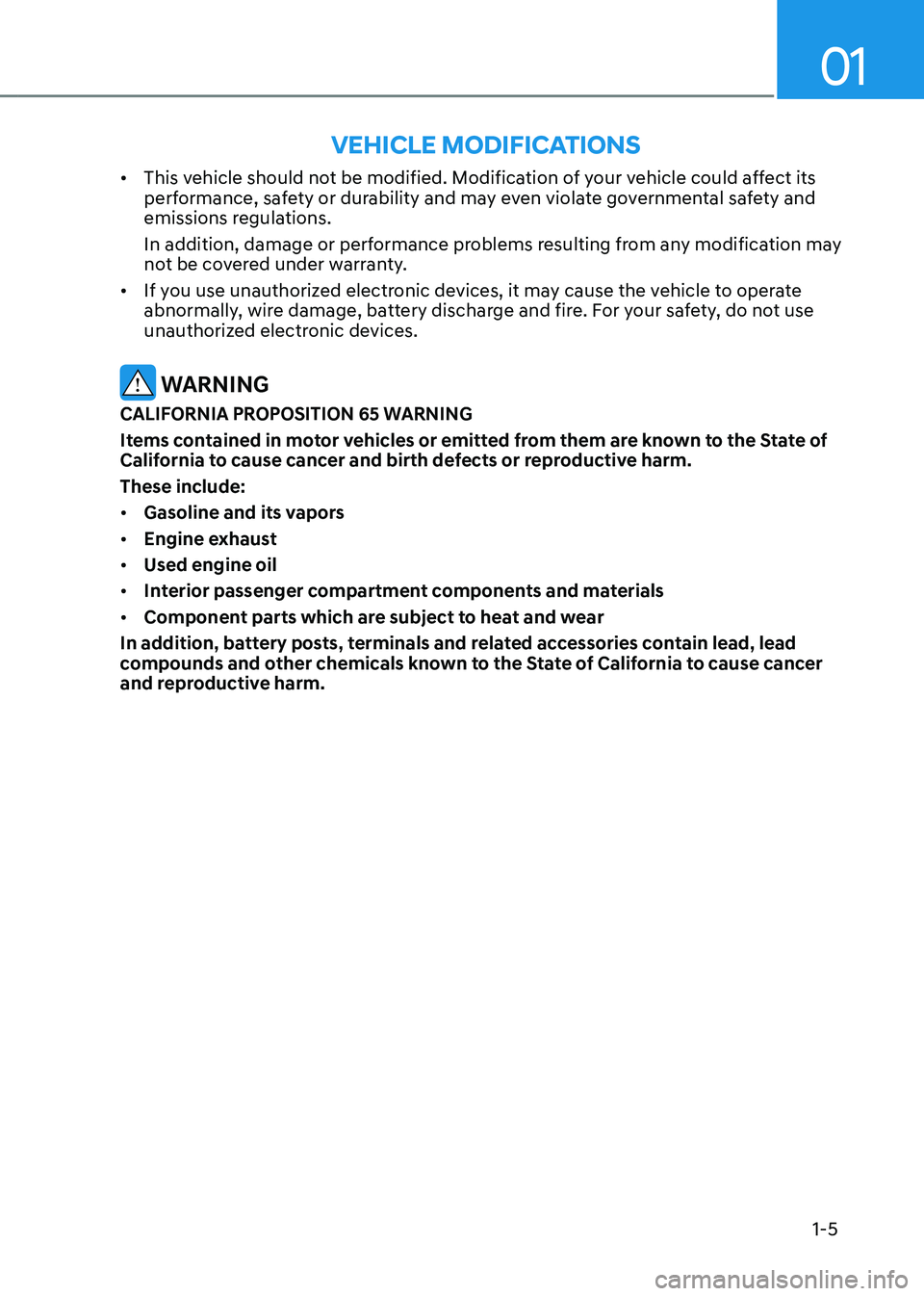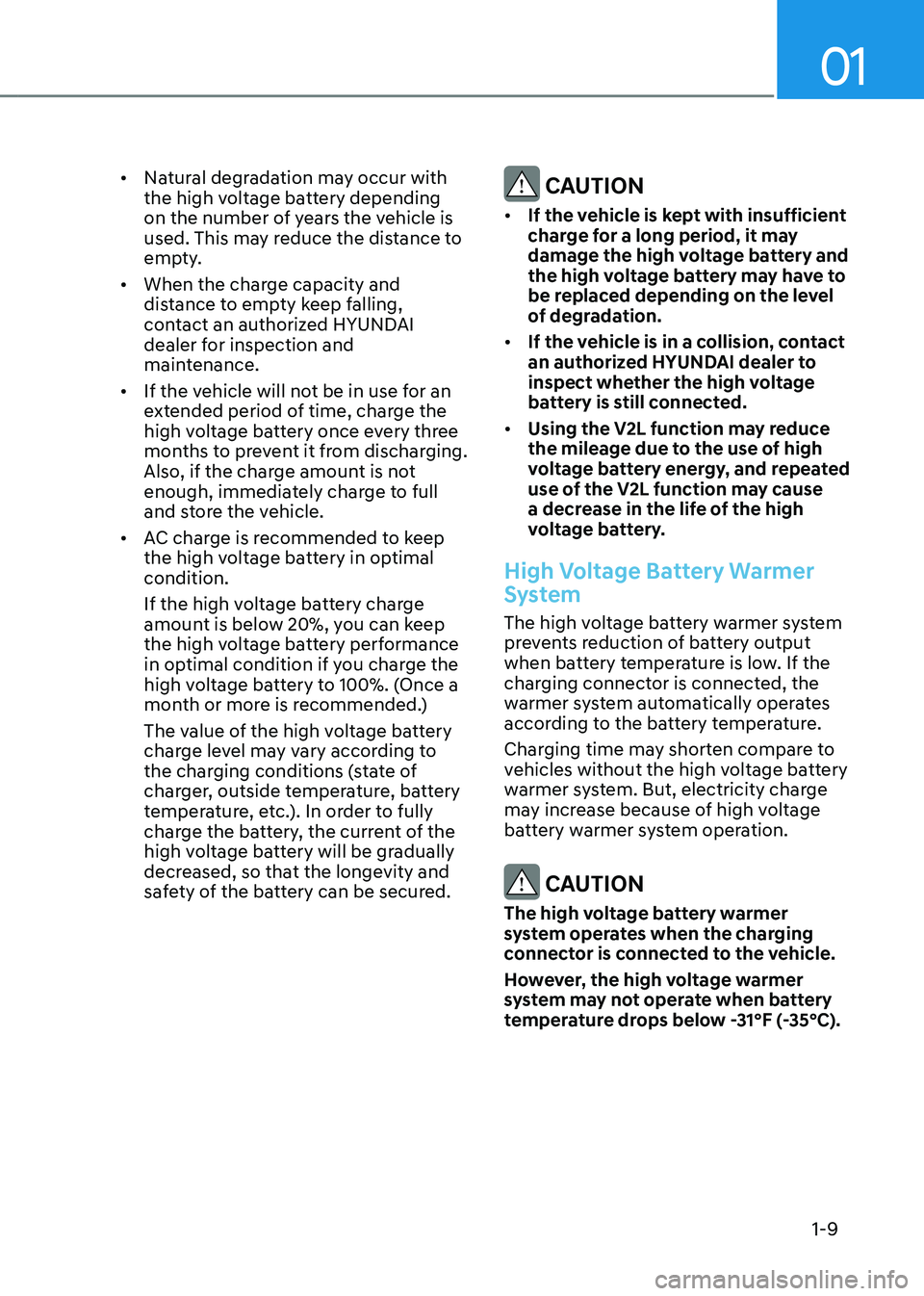2023 HYUNDAI IONIQ 5 battery
[x] Cancel search: batteryPage 6 of 680

1
Electric Vehicle...................................................................................................1 -7
Electric Vehicle .............................................................................................................. 1 -7
Characteristics of Electric Vehicles .............................................................................. 1 -7
Battery Information ....................................................................................................... 1 -7
Main Components of Electric Vehicle .............................................................. 1-8
Main Components of Electric Vehicle ........................................................................ 1-8
High Voltage Battery (lithium-ion battery) .................................................................1-8
High Voltage Battery Warmer System ........................................................................ 1-9
EV Mode ........................................................................................................... 1-10
EV Mode Screen .......................................................................................................... 1-10
Energy Information ...................................................................................................... 1-11
Next Departure ............................................................................................................ 1-12
Charging and Climate ................................................................................................ 1-13
Vehicle to Load (V2L) .................................................................................................. 1-14
Nearby Stations .......................................................................................................... 1-19
EV Settings .................................................................................................................. 1-20
Charge Types for Electric Vehicle ................................................................... 1-23
Charging Information .................................................................................................. 1-23
Charging Time Information ........................................................................................ 1-23
Charging Types ............................................................................................................ 1-24
Charge Indicator Lamp for Electric Vehicle ...................................................1-25
Charging Status ........................................................................................................... 1-25
Front Center Bumper .................................................................................................. 1-25
Charging Connector Lock ............................................................................... 1-26
Locking Charging Cable............................................................................................. 1-26
Scheduled Charging ........................................................................................ 1-27
Scheduled Charging.................................................................................................... 1-27
Charging Electric Vehicle ................................................................................ 1-28
Electric Charging Door .............................................................................................. 1-28
Charging Precautions ................................................................................................ 1-29
Unlock Charging Door in Emergency ....................................................................... 1-30
AC Charge ................................................................................................................... 1-30
DC Charge................................................................................................................... 1-34 Portable Charge ......................................................................................................... 1-36
1. Foreword / Electric Vehicle
System Overview
Page 7 of 680

1
Charging the Electric Vehicle (abrupt stop) ...................................................1-49
Action to be taken when charging stops abruptly ...................................................1-49
Driving Electric Vehicle ................................................................................... 1-50
How to Start the Vehicle ............................................................................................ 1-50
How to Stop the Vehicle ............................................................................................ 1-50
Virtual Engine Sound System ..................................................................................... 1-51
Distance to Empty ....................................................................................................... 1-51
Tips for Improving Distance to Empty ...................................................................... 1-52
ECO Driving ................................................................................................................ 1-53
Electricity Use ............................................................................................................. 1-53
Power/Charge Gauge ................................................................................................ 1-54
State Of Charge (SOC) Gauge for High Voltage Battery ..........................................1-54
Aux. Battery Saver+ .................................................................................................... 1-55
Warning and Indicator Lights (related to electric vehicle) ......................................1-56
LCD Display Messages ............................................................................................... 1-58
Safety Precautions for Electric Vehicle ..........................................................1-63
If an Accident Occurs ................................................................................................. 1-63
Other Precautions for Electric Vehicle ...................................................................... 1-64
High Voltage cut-off Switch ...................................................................................... 1-65
Page 10 of 680

01
1-5
•
This vehicle should not be modified. Modification of your vehicle could affect its
performance, safety or durability and may even violate governmental safety and
emissions regulations.
In addition, damage or performance problems resulting from any modification may
not be covered under warranty.
• If you use unauthorized electronic devices, it may cause the vehicle to operate
abnormally, wire damage, battery discharge and fire. For your safety, do not use
unauthorized electronic devices.
WARNING
CALIFORNIA PROPOSITION 65 WARNING
Items contained in motor vehicles or emitted from them are known to the State of
California to cause cancer and birth defects or reproductive harm. These include:• Gasoline and its vapors
• Engine exhaust
• Used engine oil
• Interior passenger compartment components and materials
• Component parts which are subject to heat and wear
In addition, battery posts, terminals and related accessories contain lead, lead
compounds and other chemicals known to the State of California to cause cancer
and reproductive harm.
VeHiCle modiFiCationS
Page 12 of 680

01
1 -7
Electric Vehicle
An electric vehicle is driven using a
battery and an electric motor. While
general vehicles use an internal
combustion engine and gasoline as fuel,
electric vehicles use electrical energy
that is charged inside the high voltage
battery. As a result, electric vehicles are
eco-friendly in that they do not require
fuel and do not emit exhaust gases.
Characteristics of Electric
Vehicles
1. It is driven using the electrical energy that is charged inside the high voltage
battery. This method prevents air
pollution since fuel, like gasoline, is
not required, negating the emission of
exhaust gases.
2. A high performance motor is used in the vehicle as well. Compared to
standard, internal combustion engine
vehicles, engine noise and vibrations
are much more minimal when driving.
3. When decelerating or driving downhill, regenerative braking is
utilized to charge the high voltage
battery. This minimizes energy loss
and increases the distance to empty.
4. When the battery charge is not
sufficient, AC charge, DC charge and
trickle charge are available. (Refer to
“Charge Types for Electric Vehicle” for
details.)
Information
What does regenerative braking do?
It uses an electric motor when decelerating and braking and transforms kinetic
energy to electrical energy in order to
charge the high voltage battery. (Torque
is applied in the opposite direction when
decelerating to generate braking force and
electric energy.)
Battery Information
• The vehicle is composed of a high
voltage battery that drives the motor
and air-conditioner, and an auxiliary
battery (12 V) that drives the lamps,
wipers, and audio system.
• The auxiliary battery is automatically
charged when the vehicle is in the
ready (
) mode or the high
voltage battery is being charged.
eleCtriC VeHiCle
Page 13 of 680

Foreword / Electric Vehicle System Overview
1-8
main ComponentS oF eleCtriC VeHiCle
Main Components of Electric
Vehicle
• On-Board Charger (OBC) : A device
that charges the high voltage battery
by converting AC power of the power
grid to DC power.
• Inverter : Transforms direct current
into alternate current to supply power
to the motor, and transforms alternate
current into direct current to charge
the high voltage battery.
• LDC : Transforms power from the high
voltage battery to low voltage (12 V) to
supply power to the vehicle (DC-DC).
• VCU : Control the various controls on
the vehicle.
• Motor : Uses electrical energy stored
inside the high voltage battery to drive
the vehicle (functions like an engine in
a standard vehicle).
• Reduction gear : Delivers rotational
force of the motor to the tires at
appropriate speeds and torque.
• High voltage battery (lithium-ion
battery) : Stores and supplies power
necessary for the electric vehicle
to operate (12 V auxiliary battery
provides power to the vehicle features
such as lights and wipers).
à OBC : On-Board Charger
à LDC : Low Voltage DC-DC Converter
à VCU : Vehicle Control Unit
WARNING
• Do not intentionally remove
or disassemble high voltage
components and high voltage
battery connectors and wires. Also,
be careful not to damage high
voltage components and the high
voltage battery. It may cause serious
injury and significantly impact the
performance and durability of the
vehicle.
• When inspection and maintenance
is required for high voltage
components and the high voltage
battery, contact an authorized
HYUNDAI dealer.
High Voltage Battery
(lithium-ion battery)
• The charge amount of the high
voltage battery may gradually
decrease when the vehicle is not
being driven.
• The battery capacity of the high
voltage battery may decrease when
the vehicle is stored in high/low
temperatures.
• Distance to empty may vary depending on the driving conditions
(such as outside temperature), even
if the charge amount is the same.
The high voltage battery may expend
more energy when driving at high-
speed or uphill. These actions may
reduce the distance to empty.
• The high voltage battery is used when
using the air-conditioner / heater.
This may reduce the distance to
empty. Make sure to set moderate
temperatures when using the air-
conditioner/heater.
Page 14 of 680

01
1-9
•
Natural degradation may occur with
the high voltage battery depending
on the number of years the vehicle is
used. This may reduce the distance to
empty.
• When the charge capacity and
distance to empty keep falling,
contact an authorized HYUNDAI
dealer for inspection and
maintenance.
• If the vehicle will not be in use for an
extended period of time, charge the
high voltage battery once every three
months to prevent it from discharging.
Also, if the charge amount is not
enough, immediately charge to full
and store the vehicle.
• AC charge is recommended to keep
the high voltage battery in optimal condition.
If the high voltage battery charge
amount is below 20%, you can keep
the high voltage battery performance
in optimal condition if you charge the
high voltage battery to 100%. (Once a
month or more is recommended.)
The value of the high voltage battery
charge level may vary according to
the charging conditions (state of
charger, outside temperature, battery
temperature, etc.). In order to fully
charge the battery, the current of the
high voltage battery will be gradually
decreased, so that the longevity and
safety of the battery can be secured.
CAUTION
• If the vehicle is kept with insufficient
charge for a long period, it may
damage the high voltage battery and
the high voltage battery may have to
be replaced depending on the level
of degradation.
• If the vehicle is in a collision, contact
an authorized HYUNDAI dealer to
inspect whether the high voltage
battery is still connected.
• Using the V2L function may reduce
the mileage due to the use of high
voltage battery energy, and repeated
use of the V2L function may cause
a decrease in the life of the high
voltage battery.
High Voltage Battery Warmer
System
The high voltage battery warmer system
prevents reduction of battery output
when battery temperature is low. If the
charging connector is connected, the
warmer system automatically operates
according to the battery temperature.
Charging time may shorten compare to
vehicles without the high voltage battery
warmer system. But, electricity charge
may increase because of high voltage
battery warmer system operation.
CAUTION
The high voltage battery warmer
system operates when the charging
connector is connected to the vehicle.
However, the high voltage warmer
system may not operate when battery
temperature drops below -31°F (-35°C).
Page 16 of 680

01
1-11
Energy Information
ONE1Q011006N
Select ‘EV → Vehicle image’ on the
screen.
You can check battery information and
energy consumption. Battery informationONE1Q011001L
You can check the reachable range, total
battery power remaining, and expected
charging time for each charge type. • The distance to empty is calculated
based on the real-time electric energy
efficiency while driving. The distance
may change if the driving pattern changes.
• The distance to empty may vary
according to the change of the driving
pattern even if the same target battery
charge level is set.
Page 17 of 680

Foreword / Electric Vehicle System Overview
1-12
Next Departure
ONE1Q011016N
Select ‘EV → Next Departure’ on the
screen. You can set the date and time
of when to charge the battery, climate
control temperature, and other various functions. Departure timeONE1Q011017L
ONE1Q011053L
1. Set anticipated departure time for scheduled charging and target
temperature.
2. Select the day of the week to activate scheduled charging and target
temperature for departure time.